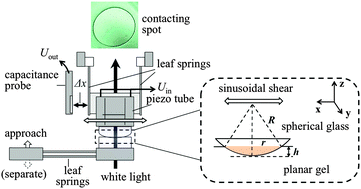Friction of polymer hydrogels studied by resonance shear measurements†
Abstract
The friction between an elastomer and a hard surface typically has two contributors, i.e., the interfacial and deformation components. The friction of viscoelastic hydrogel materials has been extensively studied between planar gel and planar substrate surfaces from the viewpoint of an interfacial interaction. However, the geometry of the contact in practical applications is much more complex. The contribution of geometric and elastic deformation terms of a gel to friction could not be neglected. In this study, we used resonance shear measurements (RSMs) for characterizing the shear response of a glass sphere on a flat polymer hydrogel, a double network (DN) gel of 2-acrylamide-2-methylpropanesulfonic acid and N,N-dimethylacrylamide. The contact mechanics conformed to the Johnson–Kendall–Roberts theory. The observed resonance curves exhibited rather sharp peaks when the DN gel and the silica sphere were brought into contact, and their intensity and frequency increased with the increase in the normal load. We proposed a simple physical model of the shearing system, and the elastic (k2) and viscous (b2) parameters of the interface between a silica sphere and a flat DN gel were obtained. The friction force from elastic deformation and viscous dissipation terms was then estimated using the obtained parameters. It was revealed that the elastic parameter (k2) increased up to 1780 N m−1 at a normal load of 524 mN, while the viscous parameter (b2) was zero or quite low (<0.1 N s m−1) for a silica sphere (radius of 18.4 mm). Thus, the friction force between a flat DN gel and a silica sphere in air was dominated by the elastic term due to the local deformation by contact with the silica sphere. By adding water, the elastic parameter (k2) remained the same, while the viscous parameter (b2) slightly increased. However, the viscous term fviscous was still much smaller than felastic. To the best of our knowledge, this study was the first quantitative estimation of the contribution of the elastic deformation term to the friction in the case when deformation of non-flat contact regions occurs. The obtained results can be basic knowledge for designing gels for applications such as artificial cartilages and sliding bearings.


 Please wait while we load your content...
Please wait while we load your content...